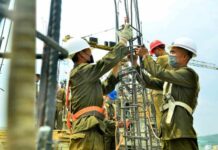[imText1]
North Korea’s nuclear testing facility at Punggye-ri in North Hamkyung Province was active just days after the third nuclear test on February 12th, analysis published by U.S.-based website ’38 North’ has revealed.
However, the analysis is insufficient to conclude what is likely to happen next at the site.
The website revealed on the 20th, “While there was no visible vehicular or human movement in the area one day after the blast, perhaps to ensure that the levels of radioactivity at the site were safe, the area was active by February 15th.”
The images analyzed for the latest report were taken one, and again three, days after the test, on February 13th and 15th.
The website analysis goes on, “At the Northern Building Complex (West Portal) there is no evidence of activity a day after the test but by February 15th, the access road and surrounding area appear to have been cleared, although some of the change may also be due to melting snow. The possible camouflage netting covering activity near the alleged tunnel entrance for the 2009 test is visible.”
It also notes signs of extensive movement in the administrative area of the test site, and at the entrance to the so-called “South Tunnel.” However, the piece notes that the available data set has not allowed experts to pinpoint the tunnel used for the third test, a problem that is likely to hinder immediate analysis of the likelihood of a fourth.
It explains, “It remains unclear whether renewed activity at the site is normal for the days after a nuclear detonation or if it is an indication of Pyongyang’s intention to conduct another test in the near future. It is also unclear whether Pyongyang will be in a position to conduct another nuclear test in the near future. If a second tunnel at the Northern area/west portal was used to conduct the third nuclear detonation, and this is not yet proven, then the Southern tunnel would be readily available for a fourth test.”

















